1.2 Science and Technology to Create a New Society
1.2.2 Science and Technology to Vitalize the Economy
Summary
Amidst the changes in population structure of our country with the population decrease and the aging of society with fewer children, the development and maintenance of the economy through innovation is necessary in order to create an affluent society and keep and enhance its vitality. Foreign countries also hold science and technology and innovation policies up as important government policy issues. In order to strengthen Japan's international competitiveness, it is important to actively implement policies to create innovation based on the results of ground-breaking research and development including the achievements of Japan's unique superior basic research realized at universities and public research institutes.
At universities, which are the wellspring of innovation, the efforts to revitalize research activity have been proceeding recently through the reorganization of national universities into corporations. The establishment of science and technology systems needed for innovation is also progressing, through industry-academia-government collaboration, intellectual property strategy, and the promotion of regional science and technology.
1.2.2.1 Role of Science and Technology in Economic Vitalization
(1)Impact of population reduction/aging society on economic vitality
The population structure in Japan is changing as a result of rapid declines in population and the progression of an aging society with fewer children. It is also expected that the labor force will decrease due to the effect of the baby-boomers reaching an age range characterized by a relatively low labor force participation rate. (Figure 1-2-22) The shrinking of the labor force population constitutes a decrease to one of the important contributors to economic growth, and this is likely to become a negative factor for revitalization of the economy.
However, the changes in the labor environment, such as diversification in employment systems and raising of the retirement age to compensate for the labor shortages, may work to resolve the problem of the decline in the labor force.
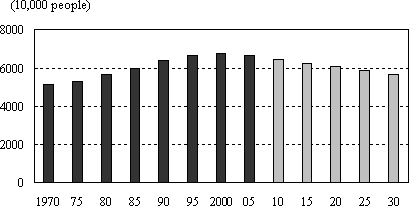
Figure 1-2-22 Labor force trends in Japan in 5 year increments
Note 1:
For 2010 and after the labor participation rate by age
group in 2004 are assumed to calculate estimated values. The future predicted
population is based on the intermediate projection.
Note 2:
The labor force is the total of working people and unemployed
people aged 15 or above.
Source:
Created by the Ministry of Education, Culture, Sports,
Science and Technology based on the Ministry of Internal Affairs and Communication
"Labor Force Survey," "Population Estimates," the National
Institute of Population and Social Security Research "Population Statistics
of Japan," OECD data, and the Cabinet Office "Report on the Japanese
Economy and Public Finance 2005"
The shrinking of the labor force is a direct negative factor for economic growth, but assuming that a certain capital is assured, the per capita capital normally increases and can result in a per capita increase in labor productivity. However, from past example in Japan, even in the midst of a transition from a slowing labor population growth rate to a decreasing trend, there has been no increase in the rate of improvement of labor productivity. Accord-ingly, a decrease in the labor force population does not necessarily result in an increase in per capita capital and an increase in labor productivity.
Looking at the relationship between the growth rate of the Gross Domestic Product (GDP) and the labor force, the GDP growth rate since 1970 has fluctuated up and down, with a gradual declining trend overall, while the trend for the labor force has been relatively stable. There is therefore no conclusive correlation between the two (Figure 1-2-23). Based on this, it is possible that some factor other than the labor force has contributed significantly to the past economic growth of the country.

Figure 1-2-23 GDP growth rate and Labor population growth rate
Note 1:
The Annual Report on National Accounts uses 68SNA through
1980, and 93SNA in subsequent years.
Note 2:
The calculation formula for the GDP deflator used a fixed
standard year method until 1994, and has used a progression method since 1995
Note 3:
The 2004 GDP growth rate is from the quarterly GDP flash
reports from January-March 2005
Source:
Cabinet Office "National Accounts," Ministry
of Internal Affairs and Communications "Labor Force Survey," Ministry
of Economy Trade and Industry "White Paper on International Economy and
Trade 2005."
With a declining population and an aging society improvements like raising the quality of the labor force and increasing productivity through the innovation that is the wellspring of science and technology, will help overcome the negative impact on the economy. It is also expected that there will be a shift from an economy that depends on "volume" to a new economy based on science and technology.
(2)Innovation and science and technology to improve productivity
An indicator to show the contribution of science and technology to economic growth is a concept called total factor productivity (TFP) contributing to the rate of growth of GDP. Total factor productivity means productivity with consideration of all factors contributing to production, except for amount of labor investment and capital stock. It increases with changes in the business climate and improvements in labor quality, and the progress of technology is said to be a major factor for such an increase.
After World War Ⅱ, Japan did not simply achieve economic recovery, but had major development as a result of high economic growth. Looking at the contributions from labor, capital, and total factor productivity to the GDP growth rate in Japan indicates that while the GDP growth rate increased from the second half of the 1950s until the end of the 1960s, the labor contribution declined or only had minute increases, showing that increases in capital and in total factor productivity made the greatest contribution increases in capital and in total factor productivity made the greatest contribution (Figure 1-2-24). For the increases in GDP growth rate in the late 1980s there was basically no change in the contributions from labor or capital, and the greatest contribution came from total factor productivity. This suggests that it could be possible to stimulate economic growth without being affected by the amount of labor investment through in-creases in total factor productivity.
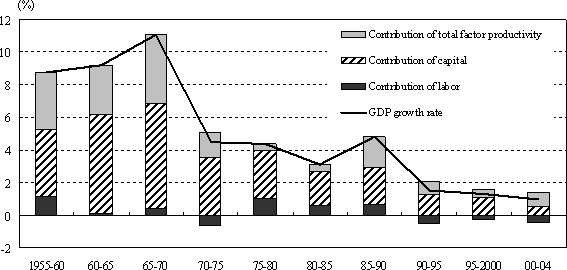
Figure 1-2-24 Attribution analysis of GDP growth rate
Note:
The labor contribution is based on man-hours.
The
capital stock for years since the 1970s have been by operating ratio.
Source:
Ministry of Health, Labour and Welfare "White Paper
on the Labour Economy 2005"
Changes in the growth rate of total factor productivity in Japan between 1990 -1995 and between 1995 -2000 were compared to data from other countries. The total factor productivity growth rates increased in Canada, the USA, and France, while it decreased in Japan, the United Kingdom, Germany and Italy (Figure 1-2-25).
In the midst of the progression of the aging of society, it is necessary to increase all-factor productivity in order to maintain and improve economic growth in Japan. Innovation and science and technology improvements are the important elements, and are expected to be even more important in the future.
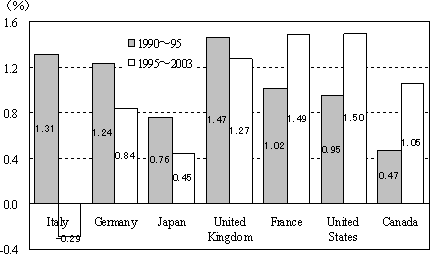
Figure 1-2-25 Changes in growth rate of total factor productivity
Source:
Created by the Ministry of Education, Culture, Sports,
Science and Technology from the OECD "Compendium of Productivity Indicators
2005"
(3)Trends in various countries on science and technology policies to achieve innovation
Modern Japan and economic societies in other advanced nations are knowledge-based economies and societies, founded on knowledge like the results of science and technology. To maintain and grow these economies it is important to make use of the knowledge base in industrial technology, develop new goods and services, and cycle the knowledge back into society and the daily lives of citizens. For this reason, the development of mechanisms to promote innovation has become an important policy issue for many countries, and a variety of science and technology and innovation policies are being developed (Table 1-2-26).
Table 1-2-26 Science and technology policies to promote innovation in various countries
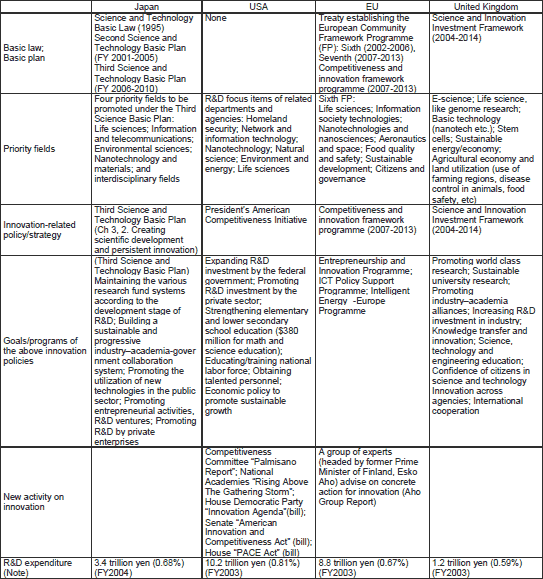
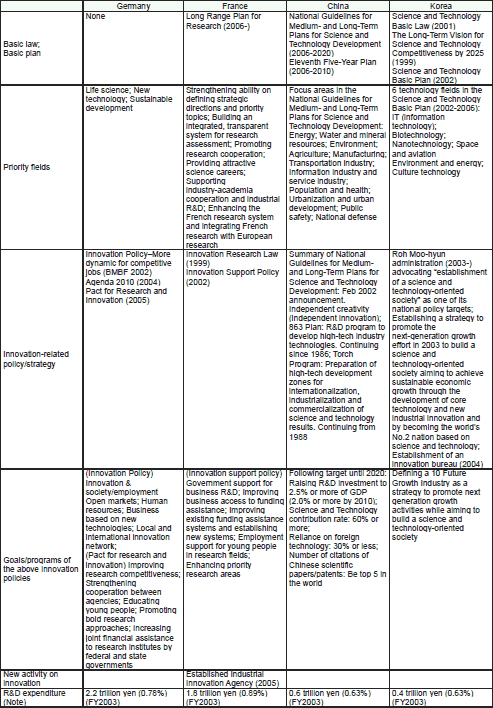
Note:
Government-financed R&D expenditures and the percentage
of GDP include the portion from the local governments. The government-financed
R&D expenditures are calculated using the IMF rates for the national currency.
For
the EU, values are based on total research funding for the 25 member states.
Source:
Created by the Japan Science and Technology Agency Center
for Research and Development Strategy from data for various countries
● USA
Since the economic stagnation in the late 1970s, there has been an emphasis on "enhancing industrial competitiveness through innovation" and adoption of policies focusing on science and technology as a "source of innovation," which have been continued to today. A characteristic of the US innovation policy is the effort to achieve the twin goals of "national security and defense" and "enhanced industrial competitiveness" by taking advantage of its competitive edge in science and technology.
In the president's State of the Union address on January 31, 2006 it was mentioned that the main policy issues were to overcome dependence on oil from the Middle East and enhanced competitive strength in order for the USA to maintain a top position in the future. The American Competitiveness Initiative announced in the address indicated emphasis on a preparation of an innovation environment, the obtaining and training of human resources, and increases in basic research in order to promote innovation through science and technology, based on the assumption that science and technology is the foundation of US competitiveness.
● United Kingdom
Based on recognition that the country's great potential had not effectively led to innovation in the past, competitiveness and innovation have been designated as important strategies. A goal of the science and technology strategy is the creation of broad benefits to society through widespread economic gains (creation of wealth and improved productivity) and improvement to the health, environment and quality of life of the people. Since the 1993 White Paper on Science, Engineering and Technology, there have been a series of strategies based on science and technology and aiming at economic development. In 2004 the "Science and Innovation Investment Framework 2004-2014," a 10 year long- term strategy, was announced, indicating measures including expansion of research and development investment, education of human resources, and alliances between the central government and local areas.
● Germany
Immediately after the reunification of eastern and western Germany, the finances of the central government were strained to support the former East Germany, and the attention on research and development declined. In addition, since Germany is a nation originally founded on traditional industries like chemicals, machinery and steel, movement into new industries, like computers, electronics, and biotechnology was delayed. At present, there are policies being hammered out to strengthen economic power through innovation and continuing growth, and to create job opportunities in the future.
In 2003 the "Agenda 2010" was announced, presenting a comprehensive program for economic growth and redevelopment of labor markets and social security systems. In 2004, it was announced that focus would be placed on "Agenda 2010 Part 2," which aims to aggressively develop innovation in research, education and vocational training.
● France
In June 1999 the Law on Innovation and Research was enacted. This law permits the establishment of companies through transfer or reassignment of researchers from public agencies, and participation by these researchers in the companies for a limited period (maximum of 6 years), such as being a board member, as well as recognizing investment in a company (limited to 15% of total capital) or provision of advice to a company on the science and technology aspects while continuing their public duties. In addition, the public agencies became able to utilize and promote research results by providing locations and facilities to business.
Since 2002 innovation support policies have been implemented. Specifically, there is government support of business research and development, simplification of access to grants by businesses, improvements to the existing grant system, establishment of a new grant system, employment support in research fields for young researchers, and strengthening priority research areas
In December 2005 the upper house of the legislature approved a bill on a long term plan for research, which is now being discussed in the committee on culture, family and social issues in the lower house.
● EU
In addition to strengthening industrial competitiveness the EU has placed a priority on science and technology as a means to achieve a variety of policy goals for health, the environment and consumer protection. In Article 163 of the union's fundamental charter (Nice Charter), the goals of research and development policies are defined as "strengthening the science and technology bases of Community industry," "strengthening international competitiveness," and "promoting the research activities required for other EU policies."
In 2000 the European Commission adopted the Lisbon Strategy, a comprehensive economic and social policy to extend through 2010. The focus is on promoting economic reform to appropriately adapt to a knowledge-based economy, and enhancing the European social model through investment in human resources, with a goal of developing a vigorous knowledge-based economy.
With regard to innovation, the Framework Program was started in 1984 as a general plan for EU research and development. At present, the 6th Framework Program is underway, covering the period from 2002-2006, and the 7th Framework Program is being created. For the competitiveness and innovation framework, there is a business innovation program, a telecommunications technology policy sup- port program, and the intelligent energy Europe program.
● China
Thus far, several measures have been taken according to the circumstances at the time, such as the "863 Plan" aimed at promoting high-tech research, and the "Torch Program" to promote the development of the foundations to support a national innovation system.
In March 2006, the outline of the 11th Five-Year Plan for National Economy and Social Development was announced by the Central Committee of the Communist Party of China. The 9th Nine-Year Plan through fiscal year 2000 and the 10th Five-Year Plan through fiscal year 2005 rapidly raised the level of science and technology, and in the 11th Five-Year Plan outline, one of the two main goals described is to reduce the consumption of energy by 20% and reduce the amount of primary contaminants emission by 10%, revealing a clear policy trend toward handling the pressing problems of resources and the environment.
In February 2006 an outline of a national mid and long-term plan on science and technology development for the next 15 years was announced. In this plan the idea of "independent innovation" is raised, with concrete goals established, such as raising research and development investment to no less than 2.5% of GDP by 2020, decreasing the dependence on foreign technology to below 30%, and having the frequency of citation of patents and scientific reports of Chinese people ranked in the top 5 in the world.
● South Korea
In 1999 the "Long-range Science and Technology Development Vision Toward 2025" was established, with a goal of promoting science and technology competitiveness to the G7 level by 2025. In 2001 the Science and Technology Basic Law was enacted. The Science and Technology Principle Plan (2002 - 2006) was enacted in conjunction with a 5-year plan on science and technology reform that was already underway. In 2004, the Headquarters of Science and Technology Innovation was established under the Ministry of Science and Technology.
Each country has put forward science and technology and innovation policies, along with the support for research and development, aimed at the utilization and development of research results and return of benefits to society. For a nation like our own, with few natural resources, it is important to actively continue with policies to promote innovation based on science and technology in order to strengthen international competitiveness.
1.2.2.2 Measures Connecting Science and Technology with Innovation
As countries adopt innovation policies and global competition becomes more intense, it is important to develop new technology and to continue to effectively connect the superior research results to innovation, while also promoting and ensuring diversity in basic research, such as by universities and public research institutions which are the sources of innovation, in order to maintain and develop Japan’s economic growth. Therefore, it is necessary for industry, government and academia to work together to enhance the systems for generating innovation. There is a need to establish innovation systems that are best suited to our country, not simply mimic what other countries have done, because of differences in the basic structure and operation of businesses and universities in each country, as well as the large differences in the culture, economy and legal systems in each country.
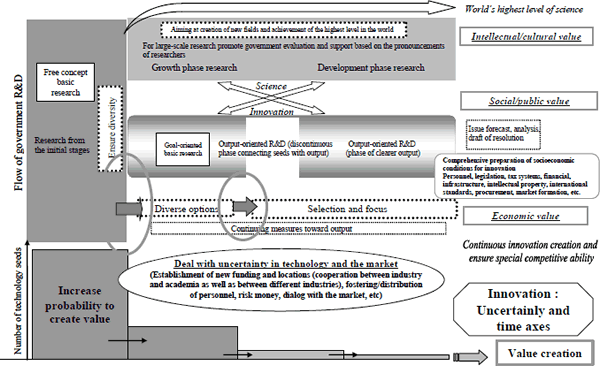
Figure 1-2-27 Development of science and creation of continuous innovation
Source:
Created by the Economic and Social Research Institute,
Cabinet Office based on the White Paper on Science and Technology 2005
(1)Promotion of basic research at universities, which are the wellspring of innovation
Universities are a source of [knowledge], and are a treasure trove of the seeds that give rise to innovation. In FY2004 the national universities and inter-university research institutes became independent organizations. As a result, there is a demand for each university to make use of their independence and autonomy to develop their own individuality and characteristics to vitalize research based on the free ideas of researchers, work in coordination with industry and the government, and make a contribution to the local area. Examples of new research and development efforts following the corporatization of national universities are below.
● Prioritization of research funds
Promote vitalization of research activities through focused distribution of funds, such as establishment of a public recruitment research project system within universities using funds under the discretion of their president, and selective distribution of the budget among departments.
● Flexible reorganization
Take advantage of the ability to flexibly reorganize that comes from incorporation, and develop systems that enable research to be conducted effectively and flexibly.
● Development of international research centers
Develop research systems and organizations to improve and fully utilize the inter-agency function throughout the country, and promote creative, cutting-edge research as an international center of research.
In order to develop world-ranked universities with the ability to lead the world in science and technology, it is important to create top class bases of research education. To achieve a research and development system that produces superior results and personnel, strategic research base formation is being performed with the goal of promoting organization and operation reforms for research and development institutes based on the vision and leadership of the organization chief, and of forming bases of superior research and personnel development that are internationally attractive (Table 1-2-28).
Table 1-2-28 Table of issues adopted for strategic research base formation
| Fiscal year adopted | Topic | Implementing institute | Summary |
|---|---|---|---|
| 2001 | Cutting edge science and technology open lab for humanity and society | University of Tokyo Research Center for Advanced Science and Technology | Open labs and off-campus organizations are established and promotion policies are advanced on returning research results to society and feedback, and training and exchange of personnel |
| Frontier Research Base Vision | Osaka University, Graduate School of Engineering Research, Frontier Research Center | The Frontier Research Center was established within the school of engineering research, and strategic fields defined to build a research base attracting the attention of the world for the research systems and results. | |
| 2002 | Formation of a base of medical research through the integration of cutting-edge fields | Kyoto University Graduate School of Medicine, Horizontal Medical Research Organization | Establishment of a research organization centered on medical research, open labs with young team leaders, a research support center and mechanisms to announce and distribute research results. |
| Venture development strategy research center | National Institute of Advanced Industrial Science and Technology, Venture development strategy research center | Preparation of an open research environment and a support system for business start-ups based on technology seeds | |
| 2003 | Formation of an advanced medical engineering research base | Tohoku University Biomedical Engineering Research Organization | Creation of biomedical engineering through the fusion of cutting-edge engineering technology with health and life sciences |
| HokkaidoUniversity research & business park concept | Hokkaido University Creative Research Initiative "Sousei" | Development of a model base of government-industry-academia alliances for economic and regional vitalization driven by science and technology | |
| A special area for innovation with young international researchers | National Institute for Materials Science, International Center for Young Scientists | Introduction of salary and human resources systems strictly based on results, and a research system using English as the primary language | |
| 2004 | Creation of a research base merging health & medicine with cutting-edge science | Waseda University Consolidated Research Institute for Advanced Science and Medical Care | Establishment of a combined research facility with the participation of researchers at the school in the fields of natural science, humanities and social science as well as medical researchers from inside and outside the school, to train young researchers to acquirer not only research skills but also the ability to identify potential for commercialization and industrialization. |
| Comprehensive research base for digital media and content | Keio University Research Institute for Digital Media and Content | Build an organization for digital content, and attract international interaction and creativity with a fusion of humanities, social sciences, science, engineering and medicine. | |
| Organization combining user-based technology and the senses | Kyushu University User Science Institute | A fusion of sensitivity and technology from a user's perspective. Building a research and development base to pioneer the new field of "user science" | |
| 2005 | Create an international integrated base of medical research and human resources development | Tokyo Women's Medical University | Formation of a base of R&D and human resources development, combining the various specialties in medicine as well as traditional medicine to establish "integrated health care" |
| Unified research institute at Tokyo Tech | Tokyo Institute of Technology | In addition to imagining the ideal society and devising solutions, build a base to actually implement the research to solve the problems | |
| Concept of "research linked to sustainability study" | University of Tokyo | Aim is to build a base that is highly-competitive internationally through partnerships between multiple institutes mediated through the University of Tokyo and sharing a theme of "sustainability" |
In order to work toward promoting innovation, from the perspective of finding research areas in which to take the lead internationally, it is likely to be very effective to concentrate investment on the formation of bases of research and education focusing on cutting-edge fusions of research areas.
(2)Enhancing systems for creating innovation
● Maintaining the various systems according to the development stage of R&D
The various research and development funding systems to support the development of science and creation of innovation must be properly prepared to handle the special characteristics and development stages of research. Expanding competitive funds (Note 13) will gradually improve the level of research and contribute to the development of a robust foundation for the creation of knowledge in Japan. In the future it will be necessary for the new scientific knowledge and technological concepts to be utilized in the economy and society in a visible manner, from the perspective of further strengthening the foundation of knowledge creation and to return the results to society.
Except for competitive funding systems, the majority of external research and development funds in Japan are assumed to be targeted at research and development of technology that is relatively close to becoming practically usable, within the range for which a roadmap can be established based on the scientific prospects. In order for Japan to produce completely new, revolutionary technology as a breakthrough based on its own promising basic research results that are still at the germination stage, and to use it for ensuring the country’s competitive strength, it is essential to strengthen research and development for creating and fostering the seeds of innovation from a diverse range of basic research results and to strengthen research and development aimed at tangible technological revolution, not mere announcements of theories.
Among the research results produced through the variety of competitively-funded research and development, there are likely to be many results that can accelerate development of innovation by being used in a different system at the next level or research and development at public research institutes. However, since there is no system for actively promoting this use of research results, there is the concern that promising results will be left on the shelf. Therefore, in addition to ensuring the systems to support research and development from the basic research stages up through the innovation stages, it is also necessary to build the means to make sure that the research results created by a certain system, university or public research agency can be appropriately utilized by the system at the next stage in order to further advance innovation.
Note 13:
A form of research and development funds for which a call
is made for a wide range of research and development topics and proposals. Several
people, including specialists evaluate the topics and proposals from the scientific
and technological perspective and select the topics that should be studied;
and the research and development funding is distributed to the researchers.
● Building a sustainable and progressive industry, academia and government collaboration system
New knowledge is created by meeting people. It is important that universities seeking to create new knowledge and theories, business seeking to develop products and services and the government join forces on research and development to foster innovation.
Since the 1980s the USA has shifted from science and technology policies focused on specific missions, like defense and medicine, to policies to strengthen industrial competitiveness, in order to respond to the economic pursuit from Japan and the EU. Laws have been enacted to promote alliances among industry, academia and government, including the Bayh-Dole Act to allow inventors to own the patents obtained through federally-funded research, and the SBIR Act, which is a program to provide funds to support entrepreneurship.
Since the establishment of the Sc ience and Technology Basic Plan in 1996 there has been sig-nificant progress on the preparation of systems to promote industry-academia-government alliances (Figure 1-2-29). In FY2004 the national universities became independent corporations, and took over various responsibilities and authority. This made it possible for each university to implement measures adapted to their own special characteristics, and allows them to hold their own patent rights. In addition, the teaching staff are no longer subject to the restrictions of the public employee system, so each entity now manages salaries and wage levels, as well as policies on outside businesses and employment.
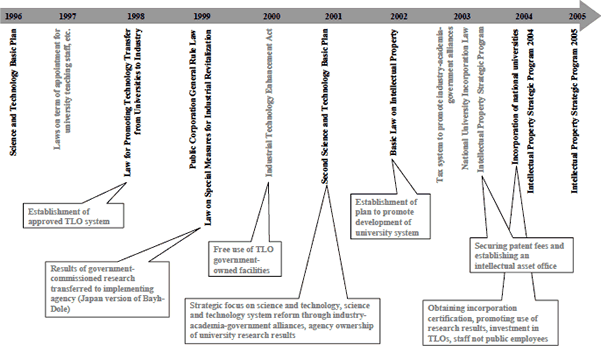
Figure 1-2-29 Main trends in industry-academia-government alliance measures
Source:
Ministry of Education, Culture, Sports, Science and Technology
At present many universities have established industry-academia-government liaison offices, and specialists in technology, law and finance have been assigned throughout the country as industry-academia-government alliance coordinators in order to increase the return of benefits to society from universities and public research agencies. While grants and endowments from business to universities remain flat, there is an increase in the number of joint-research and commissioned research projects, and a shift from the style of individual collaborations to organizational collaborations, and from non-contractual industry academia-government alliances to contract-based alliances (Figure 1-2-30). This is a change from the past situations of regular collaboration between industry and academia, with no contracts ("working in concert" type industry-academia-government alliances between specific labs and certain businesses) and the use of grant money with no restrictions on allocation of use and annual carry-over. Many of the joint research projects are in the area of life science.
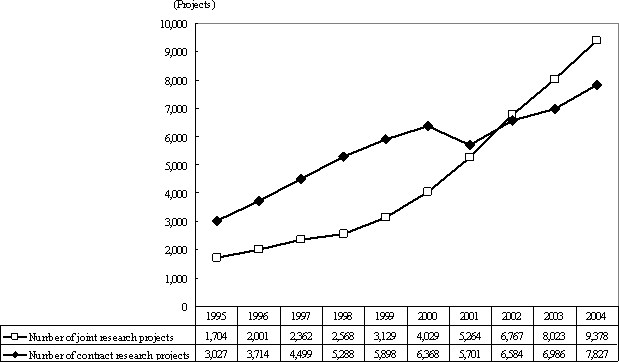
Figure 1-2-30 Trends in the Number of Joint Research/Contract Research Projects (National Universities, etc.)
Notes 1:
In FY2004 the number of joint research projects at private
universities was 938, at public universities 412, and at all universities 10,728.
Notes 2:
In FY2004 the number of contract research projects at
private universities was 6,240, at public universities 1,169, and at all universities
15,236. The project total for contract research does not include clinical trials,
commissioned testing or histological surveys.
Source:
Prepared by the Ministry of Education Culture, Sports,
Science and Technology
As an effort to promote industry-academia alliances, the nation is implementing creative seed development projects to conduct research and development for the technology stage with the aim of commercializing unique and creative research results (seeds) from the universities and public research agencies, and an industry-academia collaborative seed innovation project was established in fiscal year 2006 with a new matching grant format.
Even with the adjustment to the foundations of industry-academia-government alliances, as described above, the investment of outside sectors is small in comparison to the USA. The funds invested by companies are mostly used for company-internal research. In addition, although the amount of research and development funding received by universities from business within Japan is gradually increasing, in fiscal year 2004 Japanese business invested 201.2 billion yen in research and development overseas, but only 83.6 billion yen of research funding was received by universities in Japan from companies, less than half of the amount sent abroad (Note 14) (Figure 1-2-31). In a questionnaire survey conducted in August 2001 by Nippon Keidanren, domestic businesses were asked the reasons for offering funding to universities overseas. The answers included the ability to make flexible contracts with universities that had corporate status, the proposals from the universities based on society demands, and the horizontal cooperation systems for human resources within the universities, such as between administrative groups and instructors in other departments. According to the "FY2001 Survey on Research Activities of Private Businesses" report, the expectations of Japanese business regarding the promotion of research and research content at universities and national institutes were highest for "not just basic research, but also research that considers commercialization." There is a demand for universities to learn and understand the needs of industry, and to actively engage in industry-academia-government alliances.
Note 14:
The breakdown of research and development investment
from domestic business to overseas is very likely to include funding to subsidiary
companies, so further investigation is required.
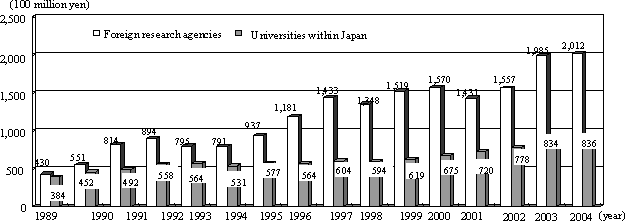
Figure 1-2-31 Research and development expenditures from industry to domestic and foreign research agencies
Source:
Created by the Ministry of Education, Culture, Sports,
Science and Technology from the Ministry of Internal Affairs and Communication
Statistics Bureau “S Report on the Survey of Research and Development”
With the development of industry-academia- government alliances, there is a growing need for regulation/accommodation of the responsibilities and benefits of teaching staff in relationship to the company and their responsibilities of education and research to the university (so-called "conflict of interest," "conflict of responsibilities"). Nearly half of all the national universities already have some sort of rules regarding conflicts of interest, but it is necessary to continue to encourage the preparation of regulations.
According to the questionnaire survey in the report "2004 Survey of the State of Japan’s Research Activities" although in general the assessment of researchers regarding the effectiveness of industry-academia-government alliance was positive, including "can secure research ability that is lacking," "can utilize research networks of the collaboration partners," and "can obtain knowledge stock (data, methods) needed for research," there were strong calls for "coordinator personnel training/enrichment " (Figure 1-2-32).
In the results from the questionnaire for the "Current Situation Surrounding Technology Transfers and Future Measures" conducted by the Ministry of Economy, Trade and Industry in June 2005, there is dissatisfaction in the industrial world about the lackadaisical observance of confidentiality requirements by students in the labs, and the handling of company secrets, such as during presentations of new research results at academic conferences. In addition, for collaborative research, although industry generally agrees to arrangements for paying indirect expenses (Note 15) requested by the university, there are problems with payment ambiguities such as amounts, and accounting for how the money is used. For patents jointly owned by a university and a business, since the university cannot utilize the patent itself, they sometimes ask the business for royalty payments to utilize the shared patent (compensation for non-implementation), in order to ensure a source of funding for new research activities and provide financial incentives to inventors. However, paying this kind of compensation can be an obstacle to business, especially in the case of one product that utilizes multiple patents, such as in the electric industry, and there are gaps between the attitudes and awareness of business and universities. In the same survey the universities voiced the opinion that businesses should have an attitude of flexibility and a long- range point of view for negotiations and an integration of the contacts for business.
In order to resolve these various problems, the industrial world must consider the unique characteristics of universities and public research agencies, and universities must flexibly adapt to the needs of business. It is necessary to build relationships based on mutual trust, including strict observance of confidentiality without compromiseng the function of broadly releasing research results that should be filled by universities. To achieve this, it is crucial to have personnel who are clear about the situations in the respective areas of industry, academia and government, to exchange researchers among each of these groups, to foster the development of MOT (manager of technology) personnel, and to increase the number of coordinators.
Note 15:
Facilities expenses, etc. for test equipment besides the
direct research expenses.
(Reasons for effectiveness of industry-academia-government alliances)
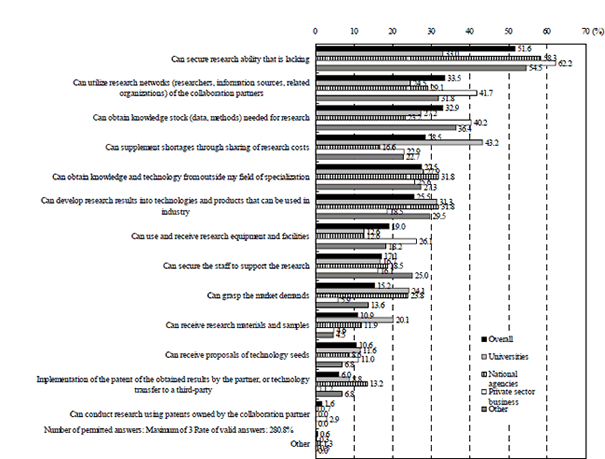
(What is needed for industry-academia-government alliances)
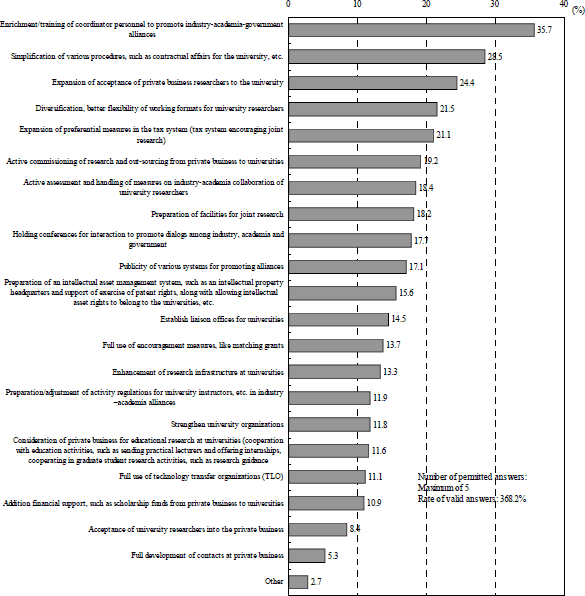
Figure 1-2-32 Opinions of researchers involved in industry-academia-government alliances
Source:
Ministry of Education, Culture, Sports, Science and Technology
"Survey of the State of Japan's Research Activi-ties" report (2004)
● Creating, protecting and utilizing intellectual property
In order to boost innovation, it is essential to stimulate the intellectual creative activity cycle and ensure that the resulting intellectual property is properly protected and utilized.
Intellectual property is expected to fill two roles. One is to motivate research and development. If there is no protection of intellectual property rights, and other companies can use the developed knowledge without prior consent, it will decrease the incentives to invest in research and development. The second role is to encourage the public release of research and development. Patent rights are intellectual property rights that require publication as a condition of the protection, so by strengthening this, it is possible to avoid having research become a business secret and prevent redundant investment by other companies. On the other hand, excessive protection hinders technological innovation, so it is necessary to seek an appropriate protection balance.
(1)Transferring the research results from universities to society
With regard to the handling of inventions at national universities, in principle, since the Science Council decision in 1977, ownership is vested to the individual. However, without promotion of transfer and use of intellectual assets to industry, the intellectual assets tended to remain on a shelf, so there has been a shift to management of intellectual property, like patents, by the organization (principle of organizational ownership). With the implementation of the University Intellectual Property Centers Program in FY2003, there has been progress on the establishment of intellectual property headquarters at universities. In addition, as a result of the incorporation of the national universities in FY2004 each university took over the rights and responsibilities related to intellectual property, and have developed systems to utilize intellectual property according to their own judgment. As a result, universities became able to make use of the intellectual property according to their own judgment. At present, it has also become possible for national university corporations to accept stock as compensation for permission to use their intellectual property.
As a result of the measures described above, there has been an increase in the number of patent applications and cases of licensing by universities, but in comparison to the USA, the royalty revenues are low, and the rate of increase in royalty revenues is low compared to that in the number of patent license agreements by universities. However, it is true that it took a long time after the Bayh-Dole Act was enacted until economic benefits, like royalty revenues, were generated by the university research results in the USA. Considering too, that a long time is required from investment in research until product commercialization for fields like life sciences, it is likely that the lack of significant results in Japan so far are to be expected. In fact, the United Kingdom started the establishment of TLO at universities in the late 1980s, about 5 to 10 years behind the USA, and has not yet achieved royalty revenues on par with those in the USA (Figure 1-2-33). For technology transfers, the fundamental accumulation is important, and to invigorate future technology transfers it is necessary for universities to promote means to properly secure within the organization the funds for intellectual property activities, such as fees for patent applications. For this the government must increase support for competitive research and development to encourage a return of the research results born at universities back to society, and to appropriately support the costs of foreign patent applications, from the perspective of Japan's international competitiveness.
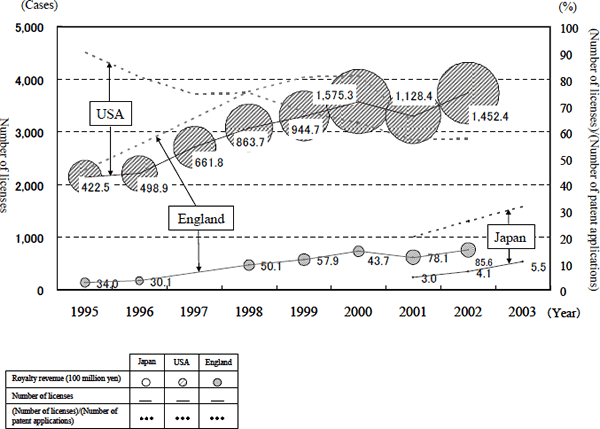
Figure 1-2-33 International comparison of trends in the results of technology transfers from universities
Source:
Created by the National Institute of Science and Technology
Policy
(2)Promoting intellectual property activities
With regard to intellectual property activities, patent applications are still mainly filed for improvement patents rather than basic patents, for defensive reasons, so there is a high percentage of unutilized patents, about 60%. It is important to utilize outstanding R&D results that become the source of global competitiveness by effectively obtaining the rights, particularly as basic patents in Japan and abroad. For businesses it is important to shift from a quantity-based patent strategy to a quality-based strategy, and work on obtaining high-quality basic patents. For universities, it is important to actively obtain the appropriate rights for their intellectual property, regardless of whether it is within Japan or abroad. It is also necessary for the country to support the strategic measures of the universities, etc. It would also be desirable to prepare patent information search systems, like the Intellectual Property Digital Library (IPDL), for using existing patent information, so that it is possible to obtain high-quality research results.
With regard to the problems of compensation for employee inventions, due in part to a great deal of conflict in recent years, Article 35 of the Patent Law was revised and entered into force in April 2005. Under the amended employee invention system, independent agreements on the appropriate compensation between the employer and the employee will be respected as long as they are reasonable.
● Promoting entrepreneurial activities of R&D ventures
Research and development-based venture businesses, such as university start-ups, quickly return ground-breaking research results from universities to society, and play an important role as a driving force of innovation. In recent years universities are not just generating the seeds that are the source of knowledge, but are also actively setting up university start-ups to develop new goods and services utilizing their own research results. The number of university-based venture companies in Japan is increasing. A noticeable increase has been seen particularly since 2000, when it became possible for professors at national universities to simultaneously hold positions in private sector businesses, with the cumulative total companies established exceeding 1,000 in 2005 (Figure 1-2-34).
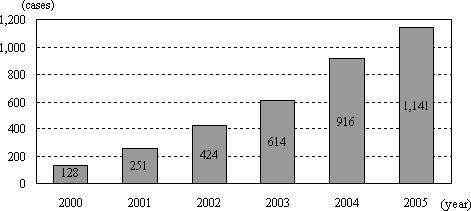
Figure 1-2-34 Cumulative total of university-based start-ups
Note:
Survey subjects: National, municipal and private universities,
technical colleges, and inter-university research institutes throughout the
country (786 sites), as well as government research facilities (47 sites)
Source:
Ministry of Education, Culture, Sports, Science and Technology
"2005 University-Based Venture Start-up Survey"
In the future, in addition to continuing the preparation of the environment for entrepreneurial activity, it is necessary to enhance comprehensive support measures, covering technology, funding, human resources, and creation of demand. In particular, it is important to continue supporting creation of university-based start-up companies and to support for the growth and development of the created venture.
● Building regional innovation systems and creating vital regions
According to Professor Michael Porter of Stanford University, a "cluster" is an innovative group of inter-related businesses and agencies associated with a particular industrial field in close geographical proximity, linked by similarities and complementary functions. Various western nations are already making strategic use of clusters, emphasizing the effective use of resources and the regional autonomy. Well known examples include, Silicon Valley in the USA, Cambridge in the United Kingdom, Sophia Antipolis in France and Zhongguancun in China (Table 1-2-35).
Table 1-2-35 Table of world clusters
| Country | Region | Main field | Economic scale (area, population) | Main universities/ research institutes | Main companies/ start-ups | Development |
|---|---|---|---|---|---|---|
| USA | Silicon Valley | IT | 50 km north to south, 15 km east to west Population 2.3 million (Santa Clara county) (Note 1) |
Stanford University (slightly farther, UC Berkeley, UCSF) Extremely large number of VC |
About 5,000 high-tech companies (manufacturing: about 1,500, R&D/service: about 2,000) (Note 3), HP, Intel, Oracle, Sun Microsystems, etc. | Science Park established in the 1950s, Spin-off from Fairchild Co., 1980s major global corporations establish labs |
| Austin (Texas) | IT | Working population 100,000 (mainly high-tech companies) (Note 2) | Texas University Austin | Number of high-tech-related companies, like Dell: about 1,750 (Note 2) | 1980s: government semiconductor research project, Many IT venture companies appear through the activities of Mr. Kosmicki | |
| Boston metropolitan area | Medical equipment, Bio-tech | Population along Rte 128, about 700,000 (City of Boston + Town of Cambridge) (Note 4) | MIT, Harvard, Boston College, etc. Major hospitals, such as Massachusetts General |
Bio-related companies: about 250 (18% of entire USA) (Note 3), of these 65 are venture companies Medical device companies: 100, Biogen, Genzyme |
From the 70s through the 80s researchers from Harvard and MIT started a series of bio-tech start-ups | |
| Research Triangle Park (North Carolina) | Pharmaceutical bio-tech | 3 cities of Raleigh, Durham, Chapel Hill (30 km east to west, 20 km north to south) Working population about 40,000 (Note 2) |
North Carolina State, Duke, North Carolina National Environmental Science Research Lab, Research Triangle Institute, etc. | Base of research in the USA for GlaxoSmithKline Bio venture: about 140 companies (Note 1), 65 companies are bio-research related services | The state built a research park in the 60s, and started a government recruiting project In the 90s, an increase in spin-off start-ups from GSK, State promotes bio-ventures |
|
| Great Britain | Cambridge | Bio-tech | Radius of 50 km centered on Cambridge Working population over 32,000 (Note 5) |
Cambridge University, Cambridge Science Park St John's Innovation Park |
High-tech companies: 1,250, of these about 150 are bio-related companies (Note 5) | Series of spin-offs from Cambridge University in the 1980s, In the 1990s, spin-offs from the 80s spin-offs |
| Northeast England | Nano- technology | Population 2.6 million (about 13,000 jobs created by new high-tech-related business) | 5 universities, including Durham, Newcastle, Northumbria, COE project | 1999, Northeast England Development Co. established, COE progress in 5 fields, such as nano-technology through collaboration of the 5 universities |
(Note 1) 2003, (Note 2) 1999, (Note 3) 1997, (Note 4) 2004, (Note 5) 1998
| Country | Region | Main field | Economic scale (area, population) | Main universities/ research institutes | Main companies/ start-ups | Development |
|---|---|---|---|---|---|---|
| Germany | Area around Munich (especially Martinsried) | Pharmaceutical bio-tech | Population of Munich about 1.3 million About 20% of the workers in bio-tech in Germany are here. Particular concentration of bio-venture in the suburb of Martinsried (10 km from city center) |
Technical University of Munich, Ludwig-Maximillian University Max Planck Institute of Neurobiology, National Environment/Health research center Big role played by BioM Co. About 20 VC companies |
About 100 bio-related companies, such as Heisse, and Ingenium 31 bio-venture companies like MediGene (Note 1) | Based on the results of the Max Planck Institute, in 1996 a cluster policy "BioRegio" to promote bio-industry development in Germany |
| Finland | Oulu | IT, bio-medical | Population about 1.24 million (Note 2), More that 7,500 people work at companies in Technopolis (Note 2) | University of Oulu, National technology research center (VTT) Technopolis company |
More than 500 high-tech companies in Technopolis, Nokia-related businesses | In 1980 the head of VTT proposed concept of Oulu promotion through a science park, based on this, incubation activities by Technopolis |
| France | Sophia Antipolis | Information-related, environment /life science, etc | About 24 square km Employees 22,000 |
National science lab, Nice University science lab, Paris School of Mines graduate school | Number of companies: about 1,100, including IBM, Air France, France Telecom | Concept in the 1960s. National project decided in '72. Today's form is from venture companies of the 80s and 90s |
| Korea | Taedok special research zone | High-tech | Working population: about 17,000 Students: about 30,000 Area: about 5 km2 Population of Daejeon about 1.3 million |
59 research agencies25 private research labs, 30 government- affiliated research labs, 4 higher-education facilities, 7 government agencies (Note 3) | Since 1995, 300 technology-based venture companies born, 130 companies within the incubation facilities at the university | Concept born in '71, since the Asian currency crisis in '97, spin-offs are active |
| China | Zhongguancun (Northwest part of Beijing) | High-tech | 340 square km area of northwest Beijing More than 360,000 people working at companies (Note 1) |
30 universities, more than 200 national research institutes | 10,000 companies. Growth at a pace of 2,000 companies per year (Note 3) | '88 government decision to establish a high-tech industrial development zone, in '99, Beijing defines a Science Park Zone. |
(Note 1) 2002, (Note 2) 2003, (Note 3) 2004
Source:
Ministry of Economy, Trade and Industry, "materials
by the Institute of Industrial Cluster (May 2005)"
A cluster is a concentration of the necessary business and industry functions needed for innovation. In order to promote innovation throughout Japan it is important to build competitive local innovation systems by developing local clusters with international competitive ability.
In Japan, it has traditionally been common for businesses associated with a specific field to be located near each other geographically, but the connections between businesses and industry-academia-government alliances that form the "inter- relation ships" and "links through similarities and complementary functions" have been inadequate. Therefore, in fiscal year 2002 the "Knowledge Cluster Initiative" was implemented to form regional clusters, with focused investment of research funds within a relatively limited space in order to develop an industry-academia-government network to leverage the superior technology resulting from the research. There are 18 regions targeted as knowledge clusters in the current project, with 2,145 researchers participating in industry, academia and government, resulting in 1,060 patent applications, and 219 commercialized results (products, start-up companies, etc.). In addition, since fiscal year 2001 an "Industry Cluster Project" has been underway, to build tight networks of researchers at local universities and local middle-ranking/small and medium-sized businesses that attempt to develop new businesses, and to support research and development making use of regional characteristics, and increasing the quality and quantity of information flows between industry, academia and government. There are currently 19 projects being conducted, but in the second phase of the project from fiscal year 2006 to 2010, these will be re-organized and merged into 17 projects, along with the setting of plan goals and targets. However, since it is also possible that the measures implemented by the various ministries and agencies, not just for the clusters, may not necessarily work as desired in the region, a liaison committee of agencies associated with regional science and technology has been formed in fiscal 2004 and there are efforts to achieve cooperation and coordination among agencies and ministries.
Common elements of the successful examples of regional clusters abroad include commonly-held, long-term vision and goals, a supply of the core personnel to drive the projects, a support system that operates effectively to support the network activities within the cluster, and effective utilization of policy support for small and medium-sized business, such as venture, etc. With regard to the regional clusters in Japan, it has been pointed out that the university-based start-ups and spin-off companies (Note 16) that are the effective choices for the commercialization of research results, such as from joint research, are creatively weak. This is said to be influenced by inadequate risk management of venture capital and angel investment, and a lack of people aspiring to be entrepreneurs. The knowledge clusters and industrial clusters are still in the process of being formed, so it is too early to judge the success or failure of the cluster formation. In addition to working to promote further collaboration of the industrial clusters and knowledge clusters, it is important to vitalize regional innovation systems through active promotion of the creation and use of intellectual property using advisors on intellectual property in the local regions.
Note 16:
An independent venture of a parent company through a separate
allocation (spin-off) of business resources, such as unused technology, personnel
and capital
● Innovation activities by private enterprises
The creation of market value in the form of new products based on the results of research and development and industry-academia-government alliances, and the final realization of innovation is achieved through private business.
In December 2004 the "Statistics on Innovation in Japan" was released. This was a statistical study of the conditions and trends in innovation activities in private sector businesses in Japan. It is the first nationwide, comprehensive, objective statistical investigation of innovation conducted in Japan. According to this study, 29% of all businesses conduct innovation activities, and 22% have achieved innovation. The main obstructions reported by the companies that have achieved innovation are "enormous economic risk," "lack of capable personnel," "lack of appropriate sources of capital," and "excessively high innovation costs." (Figure 1-2-36)
In order to solve the lack of personnel for innovation within a business, it is necessary to encourage joint human resource development efforts by industry and academia and promote activities of those who have earned PhDs in industry. In order to decrease the cost of innovation, there is a need for measures to promote preparation and shared use of research facilities and to conduct research activities efficiently in a short period of time.
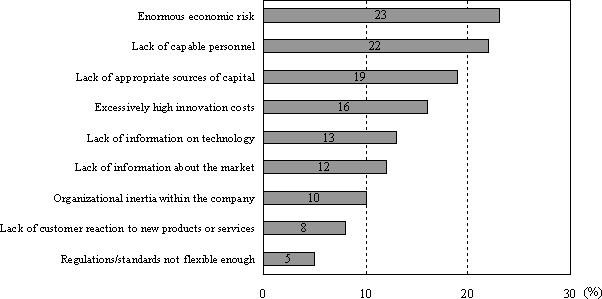
Figure 1-2-36 Innovation obstructions to innovating companies
Note:
Among the companies that have achieved innovation and responded,
the percentage of companies indicating a high level of importance (strong impact)
for the obst ructions experienced during the time innovation activities were
being conducted (1999-2001).
Source:
Ministry of Education, Culture, Sports, Science and Technology,
National Institute of Science and Technology Policy "Statistics on Innovation
in Japan" (FY2004)
With regard to the fostering of innovation within companies, the main purposes seem to be to discover new business, to increase vitality within the company and to identify the people with an entrepreneurial spirit; and, 1/3 of enterprises currently are working to foster ventures within the company, or plan to in the future. The plan in more than half the cases is to "provide funding, operation and management know-how, research results, and company operation resources, such as research and production facilities." However, the reason given for not preparing a company-internal venture system in more than half the cases is "want to focus on main business operations rather than internal ventures" (Figure 1-2-37). With regard to government support policies, more than half the companies responding indicated the importance of "expansion of public subsidies and grants for venture enterprises" (Figure 1-2-38).
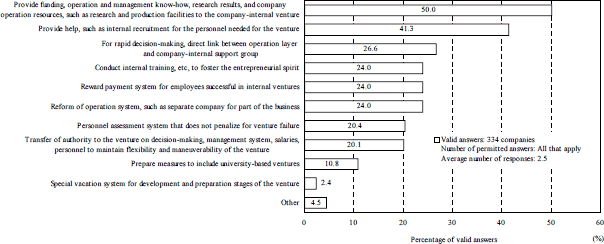
Figure 1-2-37 Policies to foster company-internal venture enterprises
Source:
Ministry of Education, Culture, Sports, Science and Technology
"Survey on Research Activities of Private Busi-nesses (fiscal 2001)"
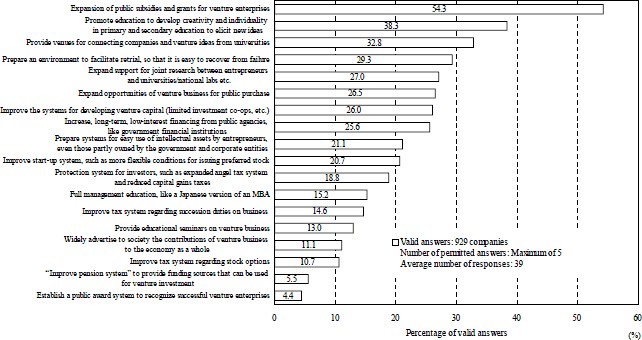
Figure 1-2-38 Government support measures needed to foster company-internal venture enterprises
Source:
Ministry of Education, Culture, Sports, Science and Technology
"Survey on Research Activities of Private Businesses (fiscal 2001)"
Measures in the tax system related to testing and research costs, include a system of tax deductions in cases where the testing and research expenses of a business exceed the average expenditure in the 3 years out of the most recent 5 fiscal years with the largest expenditure, and exceeding the expenditure of the 2 most recent fiscal years, with a deduction equivalent to 15% of the expenditure exceeding the average. A revision in 2003 established a special tax deduction system related to the total testing and research expenses, making it possible to select either the special tax deduction system for increased testing and research expenses or the special tax deduction system for total testing and research expenses. The special tax deduction system related to the total testing and research expenses is a system allowing a deduction from corporate taxes (income tax) of a certain percentage of the total expenditure on testing and research (8-10% (for each project year starting between January 1, 2003 and March 31, 2006, 10-12%)). In the case of a business commissioning research or conducting joint research with a university or public research institute, an amount equivalent to 12% of the testing and research expenses related to that joint or commissioned research (for each project year starting between January 1, 2003 and March 31, 2006, 15%) can be deducted from the corporate tax (income tax). In addition, for small and medium-sized businesses, a tax deduction equivalent to 12% of the total testing and research expenditure is allowed (for each project year starting between January 1, 2003 and March 31, 2006, 15%). In a 2006 revision of the tax system, the special tax deduction system for increased testing and research expenses and the special tax deduction system for total testing and research expenses were combined. If the testing and research expenditure is greater than the average of the last 3 fiscal years, and is greater than the amount in the last 2 fiscal years, the tax deduction rate is increased by 5% for the portion of the expenses exceeding the average.
Public procurement is also important not only for enhancing the activities or improves efficiency of the public sector, but also from the perspective of encouraging a return of research results to society. In particular, the procurement of products, etc. of research and development-based venture enterprise by the public sector increases the business credibility, and helps to ensure revenue during the early stages of business. It is necessary to make efforts to stimulate innovation in the private sector and form new markets, such as the example of the introduction of low-emissions vehicles through the plan to promote the development and adoption of low-emission vehicles by the various ministries and agencies.
1.2.2.3 To Build Innovation Systems
As society continues to age and the number of children declines it is crucial for the country to have continuous innovation in order to maintain economic vitality and international competitiveness. In the future it will be necessary for industry, academia and the government to work together and strengthen the innovation systems so that the latent abilities of the nation are utilized to the fullest extent in order to continuously and effectively achieve innovation for the ground-breaking research and development results including the basic research results from universities and public research agencies. As a nation it is necessary to prepare a variety of research funding systems to correspond to the various stages of R&D development, and to build the mechanicsms to develop promising research results from the basic research stage through the creation of useful products. Furthermore, in the midst of intense international competition, it is absolutely necessary for Japan to continuously create innovation from our own research results. Therefore, the industry academia-government alliances are important and there must be development of sustained, evolving industry-academia-government alliance system. From this there must be an effective innovation system built through promotion of the alliances, with a mutual understanding maintained through the interaction and exchanges of personnel among the various organizations. In conjunction with this, it is important to have a mechanism to eliminate the systemic and operational bottlenecks hindering smooth science and technology activities and return of the results.
Contacts
Research and Coordination Division, Science and Technology Policy Bureau
(Research and Coordination Division, Science and Technology Policy Bureau)




